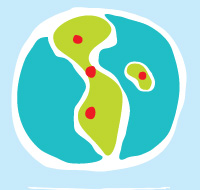How is community resilience applied by CRP LACRO?
- The CRP LACRO utilizes the Resilient Practices Methodology to provide a grounded conceptual understanding and practical application of community resilience in participating Area Development Programme (ADP) communities.
- Resilience can only be achieved when risks are reduced, and the protection of lives and livelihoods strengthened among community members and their children.
- As such, the project works with communities to assess their risk-reduction status across multiple livelihood assets and disaster or violence risk reduction priorities, along with cross-cutting issues.
- The livelihood assets considered are: human-cultural, socio-political, environmental-health, economic-financial, physical-structural, technological-scientific and psychological-spiritual.
- The disaster/violence risk reduction priorities addressed are:
- Priority 1: Understanding disaster/violence risk
- Priority 2: Strengthening governance and institutions / institutional arrangements / organizational, legal and policy frameworks to manage disaster/violence risk
- Priority 3: Investing in disaster/violence risk reduction for resilience
- Priority 4: Enhancing disaster/violence preparedness for effective response, and to Build Back Better in recovery, rehabilitation and reconstruction
- The cross-cutting issues addressed are: child protection, gender, persons with disabilities, volunteers and Christian commitments.
Critical Point Analysis.
- Utilizing the problem tree analysis, participating communities consider 15 livelihood assets and 4 disaster/violence risk reduction priorities (along with crosscutting issues), to identify the primary root cause(s) of vulnerability and hazards in the community that lead to a negative critical point(s). Conversely, the community identifies the source(s) of positive critical point(s) that will allow them to accelerate their ability to most effectively transform their community from a state of vulnerability to a state of resilience.
- The Critical Point Analysis uses a multi-tiered approach to address risk reduction, asset building, and protection factors. The negative and positive critical points need to be determined for the livelihood asset spokes and disaster/violence risk reduction priority spokes of the resilience wheel. By adopting this tool, communities can minimize their vulnerabilities and exposure to hazards while maximizing resilience—thus helping to ensure a more enabling environment for sustainable development to be achieved.























